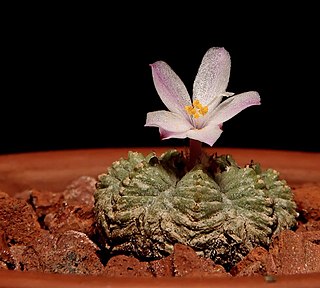
Aztekium ritteri is a species of cactus native to the Mexican state of Nuevo León.

Echinocereus viridiflorus is a species of cactus known by the common names nylon hedgehog cactus, green pitaya, and small-flowered hedgehog cactus. It is native to the central and south-central United States and northern Mexico, where it can be found in varied habitat types, including desert scrub, woodlands, dry grasslands, and short-grass prairie.

Ferocactus pilosus, also known as Mexican lime cactus or Mexican fire barrel, is a species of cactus in North America.

Cereus jamacaru, known as mandacaru or cardeiro, is a cactus native to central and eastern Brazil. It often grows up to 6 metres high.

Echinocereus poselgeri, also known as the dahlia cactus, is a species of Echinocereus. It is native to Coahuila and southern Texas.

Echinocereus pentalophus, with the common name ladyfinger cactus, is a species of Echinocereus cactus, in the tribe Echinocereeae Tribe. It is native to North America.

Echinocereus berlandieri is a species of hedgehog cactus. Its range includes most of South Texas, and is commonly found along the Nueces River and the lower Rio Grande.

Echinocereus knippelianus is a species of hedgehog cactus native to Mexico. It can be grown in cultivation.

Echinocereus nivosus is a species of cactus native to Mexico.

Echinocereus scheeri is a species of hedgehog cactus in the family Cactaceae, native to northern Mexico. With its dramatic offsets, it has gained the Royal Horticultural Society's Award of Garden Merit.

Echinocereus enneacanthus is a species of flowering plant first described by George Engelmann.

Echinocereus cinerascens is a species of cactus native from Texas to Mexico.

Echinocereus viereckii is a species of cactus native to Mexico.

Echinocereus russanthus is a species of cactus native to Texas and Mexico.

Echinocereus ledingii is a species of cactus native to Arizona.

Echinocereus maritimus is a species of cactus native to Mexico.

Echinocereus polyacanthus is a species of cactus native to Mexico.

Echinocereus adustus is a species of cactus native to Mexico.

Echinocereus laui is a species of cactus native to Mexico.

Echinocereus pamanesii is a species of cactus native to Mexico.






















